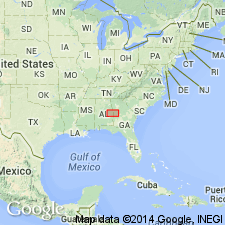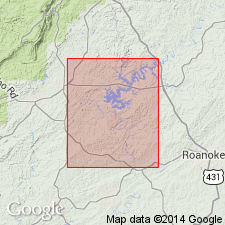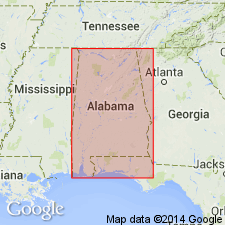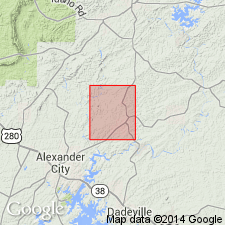
- Usage in publication:
-
- Cragford Schist
- Modifications:
-
- Original reference
- Dominant lithology:
-
- Schist
- AAPG geologic province:
-
- Piedmont-Blue Ridge province
Summary:
The Wedowee is here raised from Formation to Group rank and divided into the Hackneyville spotted Schist, the Cragford Schist, and two unnamed metasedimentary sequences. The Cragford is a fine-grained sericite and garnet-sericite schist, particularly well developed near Cragford, Clay Co., AL. Unit is generally thinly foliated and contains almandine-like garnets, usually no larger than 5 mm. Distribution of the Cragford is irregular. Weathering characteristics and saprolite development vary according to the garnet content.
Source: GNU records (USGS DDS-6; Reston GNULEX).

- Usage in publication:
-
- Cragford Phyllite
- Modifications:
-
- Principal reference
- Dominant lithology:
-
- Phyllite
- AAPG geologic province:
-
- Piedmont-Blue Ridge province
Summary:
Cragford Schist, introduced by Bentley and Neathery (1970), is here formally named the Cragford Phyllite. Unit consists of rhythmically bedded graphite-chlorite-sericite phyllite and schist. Overlies Hillabee Chlorite Schist; underlies Cutnose Formation or Hackneyville Schist, both of Wedowee Group and formally proposed in this report.
Source: GNU records (USGS DDS-6; Reston GNULEX).

- Usage in publication:
-
- Cragford Phyllite
- Modifications:
-
- Overview
- AAPG geologic province:
-
- Piedmont-Blue Ridge province
Summary:
Cragford Phyllite of Wedowee Group, as used by the Geological Survey of Alabama, consists of interbedded fine-grained graphite-chlorite-sericite schist and phyllite, garnet-sericite schist and phyllite, and graphite-quartz-sericite phyllite, with occasional thin beds of fine-grained feldspathic biotite gneiss, and locally thin interbeds of calc-silicate rock and quartzite. Generalized age of Precambrian to Paleozoic assigned to all metamorphic rocks of the Northern Piedmont of east-central AL.
Source: GNU records (USGS DDS-6; Reston GNULEX).

- Usage in publication:
-
- Cragford Phyllite
- Modifications:
-
- Revised
- AAPG geologic province:
-
- Piedmont-Blue Ridge province
Summary:
Dominant lithologies in the Cragford are dark-green to black fine-grained biotite chlorite sericite phyllite, graphite sericite phyllite, and tan fine-grained quartzite and metasiltstone. Typical exposures occur along light-duty roads and creeks in the northeast corner of T24N, R22E. Within the typical Cragford is a sequence of biotite quartzite, here referred to informally as the Enitachopco Creek quartzite member, which measures 428 ft thick in its type area in Tallapoosa Co.
Source: GNU records (USGS DDS-6; Reston GNULEX).
For more information, please contact Nancy Stamm, Geologic Names Committee Secretary.
Asterisk (*) indicates published by U.S. Geological Survey authors.
"No current usage" (†) implies that a name has been abandoned or has fallen into disuse. Former usage and, if known, replacement name given in parentheses ( ).
Slash (/) indicates name conflicts with nomenclatural guidelines (CSN, 1933; ACSN, 1961, 1970; NACSN, 1983, 2005, 2021). May be explained within brackets ([ ]).

